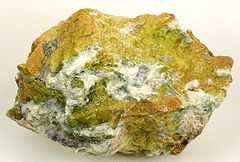Layered double hydroxides
Layered double hydroxides (LDH) comprise an unusual class of layered materials with positively charged layers and weakly bound, often exchangeable, charge-balancing anions located in the interlayer region. This is unusual in solid state chemistry: many more materials have negatively charged layers and cations in the interlayer spaces. Examples include clay mineral silicates such as kaolinite.
LDHs are commonly represented by the formula [Mz+1-xM3+x (OH)2]q+(Xn-)q/n·yH2O.
Most commonly, z = 2, and M2+ = Ca2+, Mg2+, Mn2+, Fe2+, Co2+, Ni2+, Cu2+ or Zn2+; hence q = x. Fixed-composition phases have been shown to exist over the range 0.2 ≤ x ≤ 0.33. However, phases with variable x hare also known, and in some cases, x > 0.5.[1]
Examples are also known with z = 1, where M+ = Li+ and M3+ = Al3+. In this case, q = 2x - 1. The latter family of materials can be described by the formula [LiAl2(OH)6]X∙yH2O (LiAl2-X)). X represents a generic anion and the value of y is normally found to be between 0.5 – 4.
LDHs may be formed with a wide variety of anions X (e.g. Cl-, Br-, NO3-, CO32-, SO42- and SeO42-).
The anions located in the interlayer regions can be replaced easily, in general. A wide variety of anions may be incorporated, ranging from simple inorganic anions (e.g. CO32-) through organic anions (e.g. benzoate, succinate) to complex biomolecules, including DNA. This has led to an intense interest in the use of LDH intercalates for advanced applications. Drug molecules such as ibuprofen may be intercalated; the resulting nanocomposites have potential for use in controlled release systems, which could reduce the frequency of doses of medication needed to treat a disorder. Further effort has been expended on the intercalation of agrochemicals, such as the chlorophenoxyacetates, and important organic synthons, such as terephthalate and nitrophenols. Agrochemical intercalates are of interest because of the potential to use LDHs to remove agrochemicals from polluted water, reducing the likelihood of eutrophication.
LDHs have been shown to have remarkable shape-selective intercalation properties. For instance, reacting LiAl2-Cl with a 50:50 mixture of terephthalate (1,4-benzenedicarboxylate) and phthalate (1,2-benzenedicarboxylate) results in intercalation of the 1,4-isomer with almost 100% preference. This means that there is significant potential to use LDHs to separate isomeric mixtures. The selective intercalation of ions such as benzenedicarboxylates and nitrophenols has importance because these are produced in isomeric mixtures from crude oil residues, and it is often desirable to isolate a single form, for instance in the production of polymers.
Naturally occurring (i.e., mineralogical) examples of LDH are classified as members of the Hydrotalcite Supergroup[2] of minerals, named after the Mg-Al carbonate hydrotalcite, which is the longest-known example of a natural LDH phase. More than 40 mineral species are known to fall within this supergroup.[1] The dominant divalent cations, M2+, that have been reported in hydrotalcite supergroup minerals are Mg, Ca, Mn, Fe, Ni, Cu and Zn; the dominant trivalent cations, M3+, are Al, Mn, Fe, Co and Ni. The most common intercalated anions are [CO3]2-, [SO4]2- and Cl-; OH-, S2- and [Sb(OH)6]- have also been reported. Some species contain intercalated cationic or neutral complexes such as [Na(H2O)6]+ or [MgSO4]0. The International Mineralogical Association's 2012 report on hydrotalcite supergroup nomenclature defines eight groups within the supergroup on the basis of a combination of criteria. These groups are:
- the hydrotalcite group, with M2+:M3+ = 3:1 (layer spacing ~7.8 Å);
- the quintinite group, with M2+:M3+ = 2:1 (layer spacing ~7.8 Å);
- the fougèrite group of natural 'green rust' phases, with M2+ = Fe2+, M3+ = Fe3+ in a range of ratios, and with O2- replacing OH- in the brucite module to maintain charge balance (layer spacing ~7.8 Å);
- the woodwardite group, with variable M2+:M3+ and interlayer [SO4]2-, leading to an expanded layer spacing of ~8.9 Å;
- the cualstibite group, with interlayer [Sb(OH)6]- and a layer spacing of ~9.7 Å;
- the glaucocerinite group, with interlayer [SO4]2- as in the woodwardite group, and with additional interlayer H2O molecules that further expand the layer spacing to ~11 Å;
- the wermlandite group, with a layer spacing of ~11 Å, in which cationic complexes occur with anions between the brucite-like layers; and
- the hydrocalumite group, with M2+ = Ca2+ and M3+ = Al, which contains brucite-like layers in which the Ca:Al ratio is 2:1 and the large cation, Ca2+, is coordinated to a seventh ligand of ‘interlayer’ water.
The IMA Report [1] also presents a concise systematic nomenclature for synthetic LDH phases that are not eligible for a mineral name. This uses the prefix LDH, and characterises components by the numbers of the octahedral cation species in the chemical formula, the interlayer anion, and the Ramsdell polytype symbol (number of layers in the repeat of the structure, and crystal system). For example, the 3R polytype of Mg6Al2(OH)12(CO3).4H2O (hydrotalcite sensu stricto) is described by "LDH 6Mg2Al·CO3-3R". This simplified nomenclature does not capture all the possible types of structural complexity in LDH materials. Elsewhere, the Report discusses examples of:
- long-range order of different cations within a brucite-like layer, which may produce sharp superstructure peaks in diffraction patterns and a and b periodicities that are multiples of the basic 3 Å repeat, or short-range order producing diffuse scattering;
- the wide variety of c periodicities that can occur due to relative displacements or rotations of the brucite-like layers, producing multiple polytypes with the same compositions, intergrowths of polytypes and variable degrees of stacking disorder;
- different periodicities arising from order of different interlayer species, either within an interlayer or by alternation of different anion types from interlayer to interlayer.
See also
- Fougèrite, an iron-bearing LDH mineral that is an example of a 'green rust' phase.
- Hydrotalcite, a LDH mineral.
Citations
General References
| Wikimedia Commons has media related to Hydrotalcite. |
